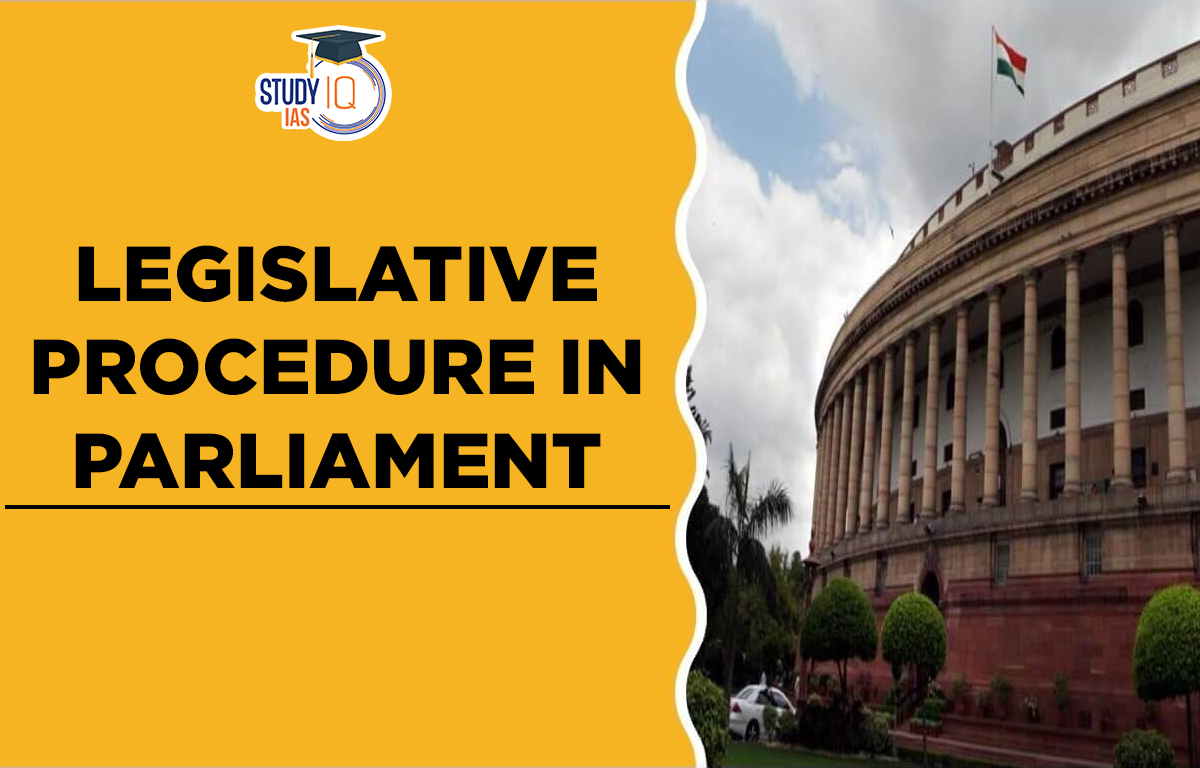Table of Contents
Legislative Procedure in Parliament
Both houses of Parliament follow the same legislative process to pass laws into law. In both houses, the bills go through the same processes. Bills might be either public or private. The executive must create specific rules and regulations within the parameters of the law, while Parliament only creates laws in their broadest sense. Delegated legislation, executive legislation, or subordinate legislation are terms for this.
The Legislative Procedure in Parliament is an important part of Indian Polity which is an important subject in UPSC Syllabus. Students can also go for UPSC Mock Test to get more accuracy in their preparations .
Legislative Procedure in Parliament of India
In each of the two Houses of Parliament, the legislative process is the same. When a bill is properly enacted, it becomes an act or law and is presented for legislation. Four categories Ordinary, Money, Financial, and Constitutional Amendment Bills can be used to categorise bills. In this article, students can read all about Legislative Procedure in Parliament and find all the important information related to it in this article.
Both government and private member bills follow the same legislative process. According to Article 109, Money Bills and Finance Bills cannot be introduced in the Rajya Sabha. They can only be discussed in Lok Sabha. This implies that they cannot be presented as Private Members’ Bills. The remaining bills may be presented in either house.
Legislative Procedure in Parliament Constitutional Provisions
The Constitution’s Articles 107 to 122 address the legislative process in relation to the passage of bills in Parliament. The terms of the introduction and passage of the Bill are described in Article 196 of the Indian Constitution.
With one exception, Articles 198 and 207 describe the steps involved in passing a Money Bill and a Financial Bill, respectively. Any House of the legislature may introduce additional bills.
Also Read: Pro-Tem Speaker
Legislative Procedure in Parliament Stages of Bills
A private member must give one month’s notice of his intention to introduce a bill if he wants to do so. The individual who wants to present the bill asks for the House’s approval before doing so. The Bill advances to the next phase if the House approves its presentation. After being introduced in the House, the bill is later published in the Gazette of India. The first reading of the bill is when it is introduced and published in the gazette.
First Reading
First Reading is the initial stage when a member wants to introduce a Bill. The member must first ask for permission from the House. Once permission is granted, the member introduces the Bill by reading its title and objectives. After that, the Bill is published in the Gazette of India. This entire process from introduction to publication is called the First Reading. No discussion on the Bill occurs at this stage. Sometimes, a Bill can be published in the Gazette before being introduced in the House, in which case permission to introduce it is not required.
Second Reading
In this, members of the Treasury and the Opposition give speeches in favour of or against the Bill’s guiding ideas. At this stage, the fundamental ideas and broad rules of the Bill are discussed. During the consideration stage of the bill, amendments are made clause by clause. There are four potential alternative actions:
The bill may be considered immediately, referred to a Select Committee of the House, referred to a Joint Committee of the Houses, or any combination of these. The law may be distributed to get the public’s view on it.
Committee Stage
It thoroughly and in-depth analyses each clause of the bill. It has full authority to call any individual, hear from experts, check the documentation, and make recommendations for Bill’s improvement. It may also change its rules, but only without changing the guiding ideas. The committee compiles its reports following professional analysis and submits them to the House.
Consideration State
The report is divided into two sections: the committee’s suggested amendments to the bill and the committee-recommended amendments themselves. At this point, the Bill will be discussed clause by clause and amendment after amendment. Each provision and amendment is examined and put to a vote separately. Members may also suggest changes. If the House approves the amendments with a majority, they are included to the Bill.
Third Reading
The third reading serves as the last one. No amendments are permitted at this point because the general concepts of the bill have already been assessed during the second reading stage, therefore the discussion is currently just focused on whether the law should be accepted or rejected as a whole. If a majority of the members present and voting approve a measure, it is deemed to have passed by the House. The bill is then approved by the House speaker and sent to the second House for consideration and approval.
Bill in Other House
The same three readings are required for the bill that was sent to the other House. The Opposite House is presented with four options for consideration in the reading after the Bill has been discussed in the first two stages. They are:
- The bill might be approved without changes. In this situation, the Bill will be regarded as having passed both Houses.
- If the originating House accepts the Bill as amended by the other House, it will be deemed to have been approved by both Houses. If, however, the originating House rejects the other House’s amendments and there is still a difference between the two Houses regarding the amendments, the President may call a joint meeting of the two Houses to break the impasse under Article 108;
- It could either completely reject the bill or decide to do nothing, which would keep the bills waiting.
Joint Sitting
New amendments cannot be proposed during a joint sitting. Exception: If these revisions led to disagreement between the two houses or were mandated as a result of the bill’s passage being delayed. A simple majority is required to pass a bill. The bill is judged to have passed both Houses if a majority of the members present and voting in the joint session vote in favour of it.
President’s Assent
A bill is sent to the President for approval after it is passed by at least half of the State Legislature, both Houses of Congress, or a joint session of Parliament, depending on the type of bill. For bills that are not Money Bills or Constitutional Amendment Bills, the President can either approve the bill, withhold approval, or send it back to Parliament with suggestions. Parliament can choose to accept or reject these suggestions. However, if the bill is sent back to the President after being revised, he must approve it and cannot refuse it. Once the President approves the bill, it becomes an Act.
Also Read: Devices of Parliamentary Proceedings
Legislative Procedure in Parliament Special Provision
Money Bill
Money Bills are specific types of bills that include only the provisions outlined in Article 110 of the Indian Constitution. They can only be introduced in the Lok Sabha by a minister and must have the President’s recommendation. If there is ever a question about whether a bill is a Money Bill, the Speaker of the Lok Sabha makes the final decision, and this decision cannot be challenged in court or by anyone else, including the President.
After the Lok Sabha passes a Money Bill, it is sent to the Rajya Sabha. However, the Rajya Sabha has limited powers regarding Money Bills: it cannot reject or amend them, only suggest changes. The Rajya Sabha must return the bill within 14 days, whether it includes recommendations or not. The Lok Sabha can then accept or reject these recommendations. If accepted, the bill is considered passed by both Houses in its new form. If rejected, or if the Rajya Sabha doesn’t return the bill in time, it is deemed passed in the original form.
Overall, in the case of Money Bills, the Lok Sabha has more authority than the Rajya Sabha. Once both Houses pass a Money Bill, it goes to the President, who can approve it or refuse it but cannot send it back for reconsideration. Typically, the President grants approval since the bill was introduced with their prior consent.
Finance Bill
Financial Bills deal with money matters, such as revenue and spending. There are two types: Financial Bill (I) and Financial Bill (II).
Financial Bill (I)
- Similar to a Money Bill.
- Can only be introduced in the Lok Sabha and requires the President’s recommendation.
- Rajya Sabha can amend or reject it.
- If there’s disagreement between the two Houses, the President can call a joint sitting to resolve it.
- The President can: Approve the bill, Reject it, or Return it for reconsideration.
Financial Bill (II)
- Treated like an ordinary bill.
- Can be introduced in either House without needing the President’s recommendation at first.
- However, it needs the President’s recommendation before being passed.
- Similar to an ordinary bill, it can be amended or rejected by either House.
- The President’s options upon receiving it are the same as for Financial Bill (I).
Constitutional Amendment Bills
- The procedure for amending the Constitution is defined in Article 368.
Deadlock in Legislative Procedure
A deadlock occurs when there’s a disagreement between the two Houses on a bill. It happens if:
- The other House rejects the bill.
- The Houses disagree on amendments.
- More than six months pass without the bill being passed.
- The Constitution allows for a Joint Sitting of both Houses to resolve this.
Joint Sitting of Parliament
- Called by the President to resolve deadlocks on ordinary and financial bills.
- Not applicable for Money Bills or Constitutional Amendment Bills.
- The Speaker of the Lok Sabha presides over the joint sitting.
- Quorum needed is 1/10th of total members.
- Governed by Lok Sabha rules, new amendments can’t be proposed except in specific cases.
- Bills passed in a joint sitting are considered passed by both Houses.
| Bills passed in joint sittings include: |
|
Legislative Procedure in Parliament UPSC
The Indian Constitution was drafted with the goal of providing impartial, effective, and honest service to its populace. Compared to the State Legislature, the legislative procedure of Parliament has greater authority. Legislative councils in state legislatures only have advisory authority, whereas, in parliament, the upper house and lower house both have equal authority, with few exceptions. Conclusion: Parliament has substantial power that manifests in a variety of different ways. Students can read all the details related to UPSC by visiting the official website of StudyIQ UPSC Online Coaching.


 Admiralty (Jurisdiction and Settlement o...
Admiralty (Jurisdiction and Settlement o...
 Enemy Property Act in India, Background ...
Enemy Property Act in India, Background ...
 Phone-tapping in India, Legal Framework ...
Phone-tapping in India, Legal Framework ...





















